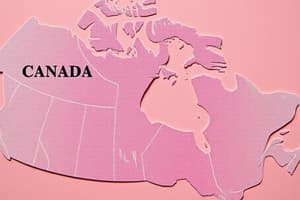Podcast
Questions and Answers
What is a primary responsibility of the Canadian Derivatives Clearing Corporation (CDCC)?
What is a primary responsibility of the Canadian Derivatives Clearing Corporation (CDCC)?
- Creating innovative OTC derivatives
- Monitoring government agencies overseeing exchanges
- Regulating OTC derivative transactions
- Clearing futures and option trades on the Montréal Exchange (correct)
Which statement best describes the regulatory environment of exchange-traded derivatives compared to OTC derivatives?
Which statement best describes the regulatory environment of exchange-traded derivatives compared to OTC derivatives?
- Exchange-traded derivatives are public and more regulated than OTC derivatives. (correct)
- Exchange-traded derivatives are private and less regulated than OTC derivatives.
- Exchange-traded derivatives are only available to institutional investors, unlike OTC derivatives.
- Exchange-traded derivatives face significant government restrictions unlike OTC derivatives.
What advantage is primarily associated with the unregulated environment of OTC derivative transactions?
What advantage is primarily associated with the unregulated environment of OTC derivative transactions?
- Increased government oversight
- Accessibility to a broader market
- Flexibility and rapid financial innovation (correct)
- Fairness in trading practices
What is a significant consequence of the regulatory environment surrounding exchange-traded derivatives?
What is a significant consequence of the regulatory environment surrounding exchange-traded derivatives?
Which of the following is true regarding the creation of new OTC derivatives?
Which of the following is true regarding the creation of new OTC derivatives?
Which comparison is accurate between exchange-traded and OTC derivatives based on their market characteristics?
Which comparison is accurate between exchange-traded and OTC derivatives based on their market characteristics?
What does buying a call option typically aim to achieve for an investor?
What does buying a call option typically aim to achieve for an investor?
What is indicated by the term 'out-of-the-money' regarding options?
What is indicated by the term 'out-of-the-money' regarding options?
How is the total premium paid calculated for the call options in the example?
How is the total premium paid calculated for the call options in the example?
What is the potential outcome if the price of XYZ shares increases?
What is the potential outcome if the price of XYZ shares increases?
What is the likely intention of a speculator in purchasing call options?
What is the likely intention of a speculator in purchasing call options?
Which component of the call option's premium reflects potential profit rather than inherent value?
Which component of the call option's premium reflects potential profit rather than inherent value?
What does the 'P' signify in the option label $17.50P?
What does the 'P' signify in the option label $17.50P?
Which value represents the latest bid price for the XYZ March $17.50 calls?
Which value represents the latest bid price for the XYZ March $17.50 calls?
What is the total options volume traded as shown in the table?
What is the total options volume traded as shown in the table?
Which option has the highest open interest?
Which option has the highest open interest?
What does 'Opt Int' refer to in the options data?
What does 'Opt Int' refer to in the options data?
What was the last sale price of the March $17.50 puts?
What was the last sale price of the March $17.50 puts?
In the context of the options market, what is the significance of 'Opt Vol'?
In the context of the options market, what is the significance of 'Opt Vol'?
What does the term 'Ask' represent in the context of the options data?
What does the term 'Ask' represent in the context of the options data?
What is the significance of the expiration month indicated in the options data?
What is the significance of the expiration month indicated in the options data?
Which strike price has an expiration date in December?
Which strike price has an expiration date in December?
What must be done to offset an OTC option?
What must be done to offset an OTC option?
What happens when a long position exercises a call option?
What happens when a long position exercises a call option?
Under what condition will an option holder typically exercise their option?
Under what condition will an option holder typically exercise their option?
What is a characteristic of buyers of options?
What is a characteristic of buyers of options?
What is the status of a call option when the underlying asset's price is lower than the strike price?
What is the status of a call option when the underlying asset's price is lower than the strike price?
What occurs when a put option is exercised?
What occurs when a put option is exercised?
What is the result when an option expires worthless?
What is the result when an option expires worthless?
What condition defines an in-the-money status for a put option?
What condition defines an in-the-money status for a put option?
Flashcards are hidden until you start studying
Study Notes
Canadian Derivatives Clearing Corporation (CDCC)
- CDCC clears futures and option trades on the Montréal Exchange.
Regulation of Derivative Transactions
- Exchange-traded contracts are public and subject to extensive regulation by exchanges and government agencies.
- OTC (Over-the-Counter) contracts are private and generally unregulated, promoting unrestricted financial innovation.
- Regulated environments ensure fairness, transparency, and efficiency, while unregulated environments allow for rapid creation of new derivatives.
Clearing and Exercising Options
- OTC options must be negotiated for offsetting, unlike exchange-traded options available for immediate offsetting by entering an order.
- Long position holders can exercise options, leading to assignment for short position holders.
- Call option exercise involves purchasing the underlying asset at the strike price; put option exercise involves selling the underlying asset at the strike price.
- Options can expire worthless; buyers have rights but no obligations to exercise.
In-the-Money Options
- A call option is in-the-money if the underlying asset's price exceeds the strike price; thus, holders benefit from exercising.
- A put option is in-the-money if the underlying asset's price is below the strike price, allowing for selling at a profit.
Example Option Pricing
- Last sale price of underlying asset (XYZ) is $17.75.
- Options expiration months include March, September, and December with varying strike prices.
- Trading details include bid, ask, last trade prices, volume, and open interest for different options series.
Call Option Strategy: Speculation
- Example demonstrates buying five XYZ December 55 call options at a premium of $2, costing the investor $1,000.
- Options are out-of-the-money, so the premium reflects only time value, no intrinsic value.
- Investors speculate on price increases; they plan to sell the options at a higher premium rather than executing the call.
Put Option Strategy: Speculation
- Put buyers anticipate price declines and seek profit from rising put values.
- Example calculates potential profit from a drop in stock price to $45, increasing put option value.
- Put buyer may realize substantial profit if the stock declines and options appreciate.
Key Takeaways
- Options function as risk management instruments, akin to insurance policies.
- Market conditions and price expectations heavily influence option trading strategies and profitability.
Studying That Suits You
Use AI to generate personalized quizzes and flashcards to suit your learning preferences.




